Statement on Monetary Policy – February 2018 4. Domestic Financial Markets
Conditions in domestic financial markets have been relatively stable, although volatility has picked up recently in equity markets. Funding conditions in Australian financial markets are easy for borrowers. The spreads on corporate bond yields relative to government bond yields are around their lowest level in 10 years and equity prices have risen over the past year. Valuations of ‘riskier’ assets increased as investors continued to search for yield. Growth in housing credit has eased, particularly for credit extended to investors. Interest rates on some housing and business loans have declined slightly over recent months. Financial market prices suggest that the cash rate is expected to increase by early next year.
Money Markets and Bond Yields
The Reserve Bank has maintained the cash rate target at 1.50 per cent since August 2016. Expectations of an increase in the cash rate have been brought forward a little. Financial market prices imply that the cash rate is expected to increase to 1.75 per cent by early next year (Graph 4.1).
Short-term interest rates in the repurchase agreement (repo) market increased significantly for a short period at the end of 2017 before returning to the levels that prevailed for most of the previous year. The increase was related to temporarily tight conditions in offshore funding markets at the end of the year. During this period, large international banks were somewhat reluctant to lend funds because the size of their balance sheets at the end of the year is used in applying some banking regulations. The tightness was particularly noticeable in the foreign exchange swap market. For instance, Australian dollars could be lent against yen at a relatively high implied Australian dollar interest rate. As a result, some investors borrowed Australian dollars under repo to use them for foreign exchange swap transactions.
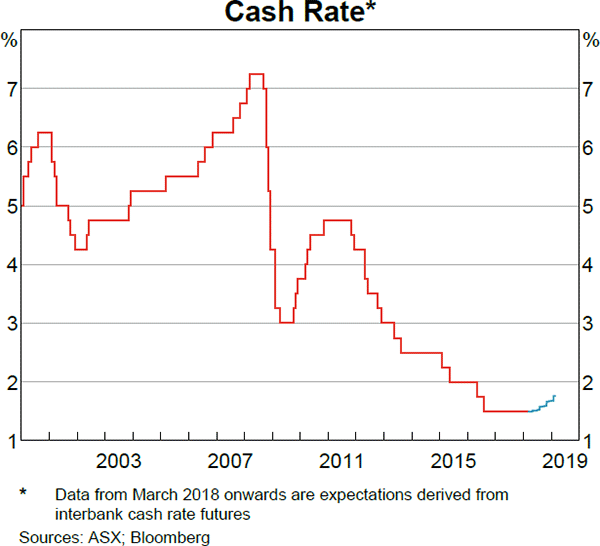
Yields on 10-year Australian Government Securities (AGS) have been relatively stable over the past year, around the very low levels of the past few years, and the spread between 10-year AGS and US Treasury yields is around its lowest level since 2001 (Graph 4.2). Recent issuance from the Australian Office of Financial Management and state borrowing authorities has been well received by the markets.
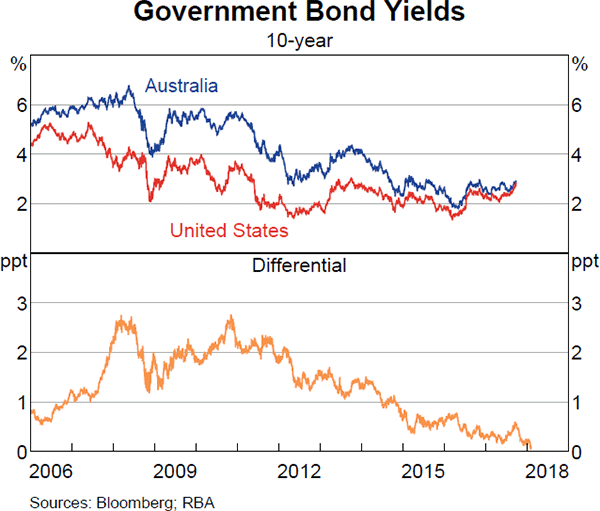
Financial Intermediaries
The funding composition of banks has been little changed over the past year, with domestic deposits continuing to comprise around 60 per cent of banks' total funding liabilities (Graph 4.3). The Net Stable Funding Ratio (NSFR), which requires banks to hold a minimum level of stable funding for their assets, came into effect on 1 January 2018. In anticipation of this, the banks had adjusted their balance sheets towards more stable sources of funding, such as longer-term securities and deposits. The banks have reported that they are above the regulatory minimum for the NSFR.
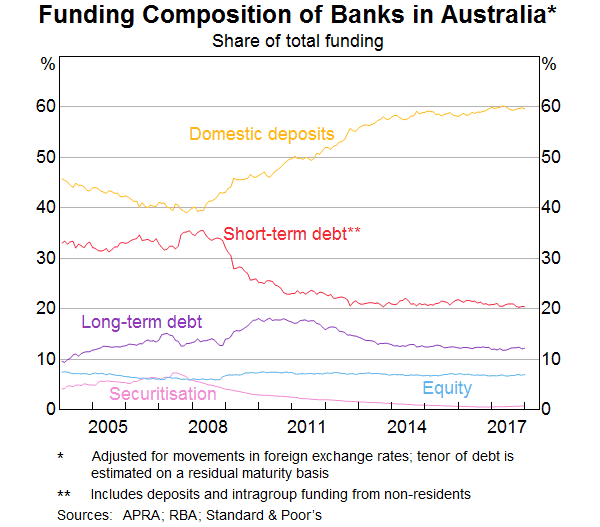
Interest rates on deposit products declined over 2017 and growth in deposits slowed; this was particularly the case for term deposits (Graph 4.4; Graph 4.5). There have also been some reductions in advertised deposit rates in recent months, especially for online saver accounts. The slowing in demand from banks for deposits reflects the combination of a decline in the growth in their balance sheets and sufficient stable funding to meet their regulatory requirements.
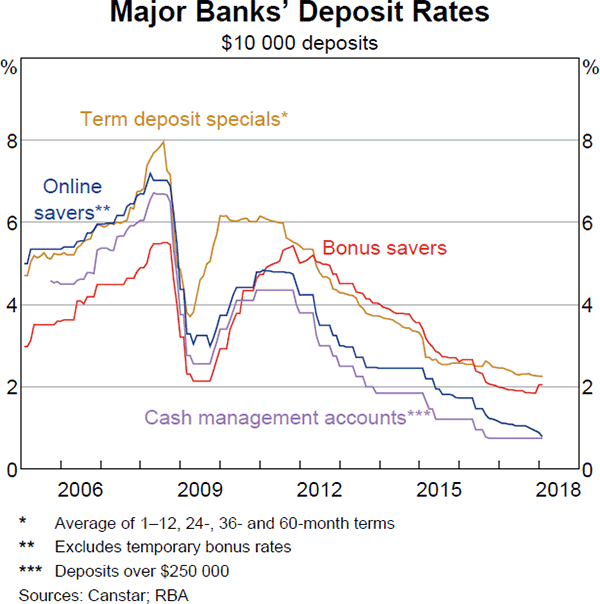
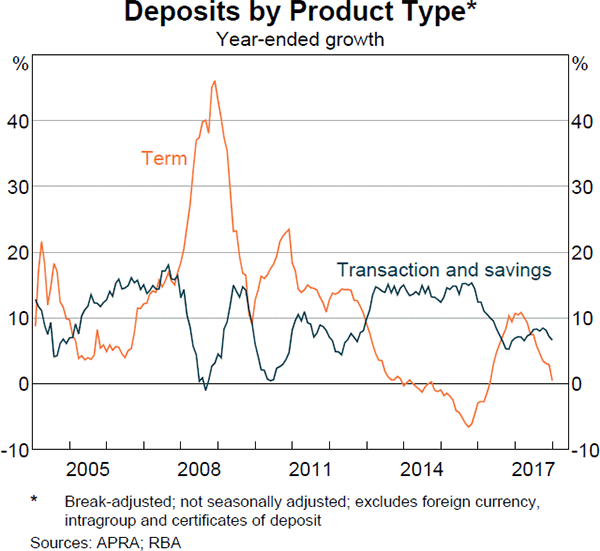
Net bond issuance by Australian banks in 2017 was above the average of recent years. Also, the average tenor of bonds issued over 2017 increased to 6 years, the highest in over 20 years (Graph 4.6). These trends reflect strong demand in the bond market, with secondary market spreads of bank bond yields to benchmark rates narrowing to be at their lowest level in 10 years (Graph 4.7).
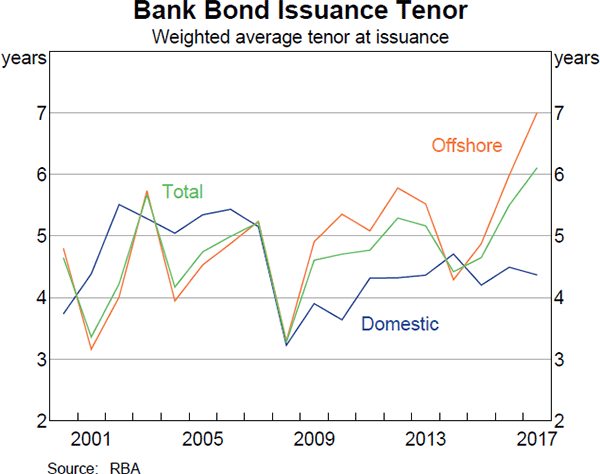
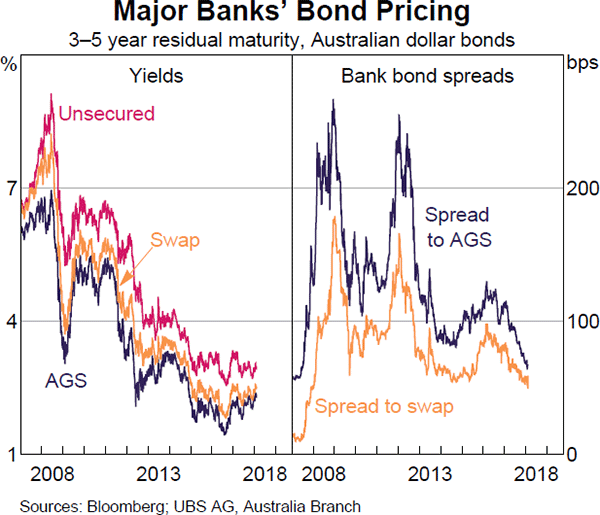
New issuance of residential mortgage-backed securities (RMBS) in 2017 was its highest in 10 years (Graph 4.8). Issuance was driven by smaller banks and non-bank originators. Market conditions have been relatively strong with primary market spreads of RMBS yields to the benchmark rate narrowing over the year.
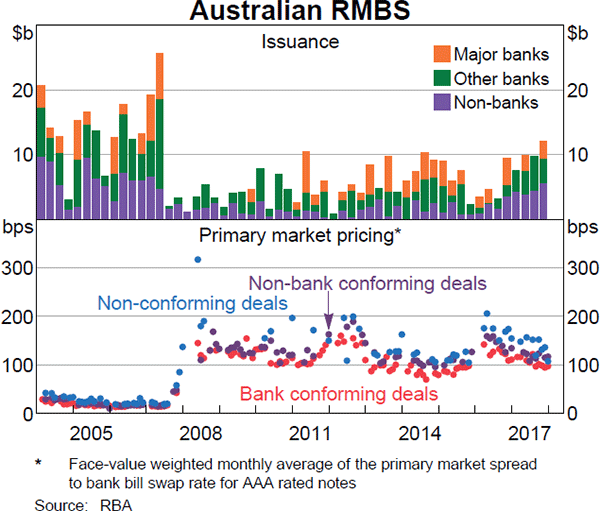
The cost of issuing short-term wholesale funding increased towards the end of 2017, although this has partially reversed more recently (Graph 4.9). The increase in bank bill rates relative to OIS towards the end of 2017 can be partly explained by a number of factors. These include reduced demand for bank bills from investment funds, and an increase in the cost of short-term offshore funding more generally. The subsequent decline in bank bill rates has been associated with a broader improvement in conditions in short-term funding markets.
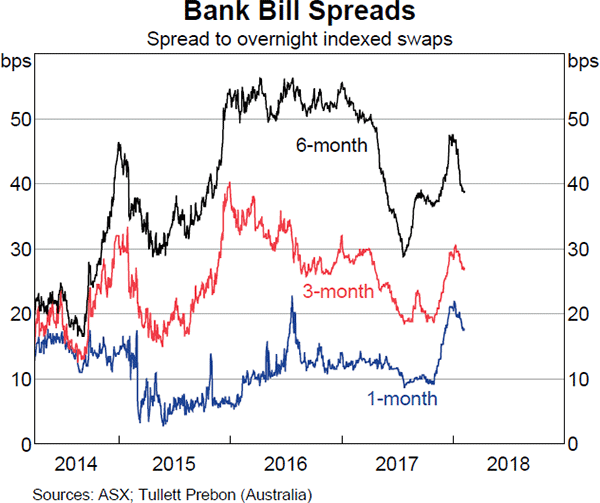
The implied spread between lending rates and debt funding costs for the banks is estimated to have been stable in recent months.
Financial Aggregates
Total credit growth moderated in recent months as housing credit growth eased and business credit growth was little changed (Graph 4.10). Broad money growth has declined recently, with deposit growth slowing (Table 4.1).
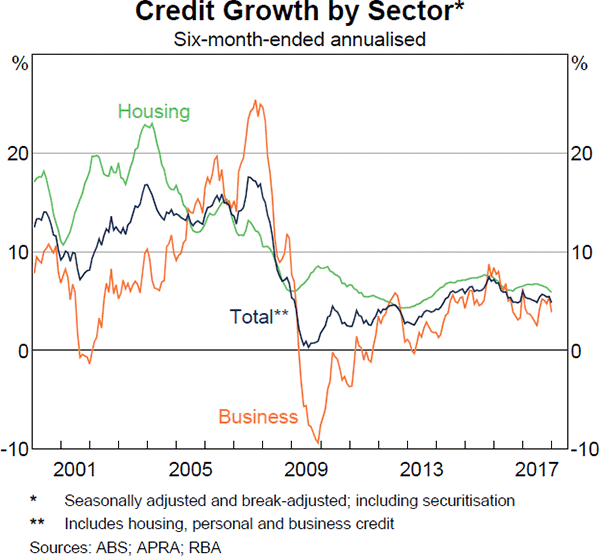
Household Financing
Growth in overall housing credit has edged a little lower, driven largely by a slowing in credit extended to investors (see Box D: ‘Measures of Investor and Owner-occupier Housing Credit’). The slowing in investor credit growth has been mainly due to slower growth in New South Wales and Queensland (Graph 4.11).
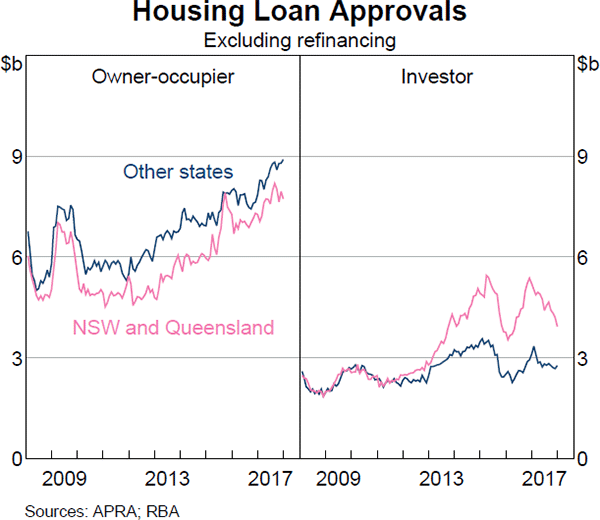
New dwelling construction has been at a high level in recent years. Accordingly, lending approvals to households for the purposes of building or purchasing a new dwelling have continued to make a strong contribution to credit growth, despite the easing in total credit growth (Graph 4.12). This is consistent with a slowing in turnover in the market for existing dwellings.
| Three-month ended | Year-ended | ||
|---|---|---|---|
| Sep 2017 | Dec 2017 | Dec 2017 | |
| Total credit | 1.3 | 1.1 | 4.8 |
| – Housing | 1.5 | 1.4 | 6.3 |
| – Owner-occupier | 2.1 | 1.8 | 7.9 |
| – Investor | 0.5 | 0.6 | 3.4 |
| – Personal | −0.2 | −0.4 | −1.1 |
| – Business | 1.0 | 0.9 | 3.2 |
| Broad money | 0.5 | 0.1 | 4.6 |
|
(a) Growth rates are break adjusted and seasonally adjusted Sources: APRA; RBA |
|||
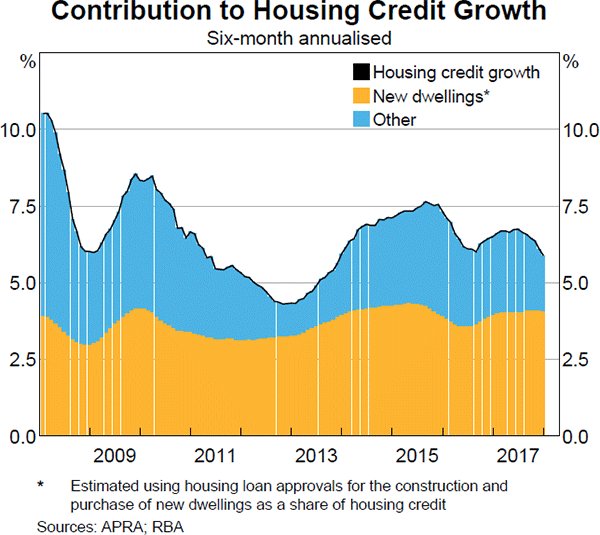
The share of housing loan approvals with interest-only payments has fallen over the past year following the prudential measures focusing on interest-only lending imposed by the Australian Prudential Regulation Authority. The share of interest-only housing loan approvals averaged less than 20 per cent in the December quarter, down from around 35 per cent in 2016. This share has declined most notably for investors, although it remains higher than the share for owner-occupiers (Graph 4.13).
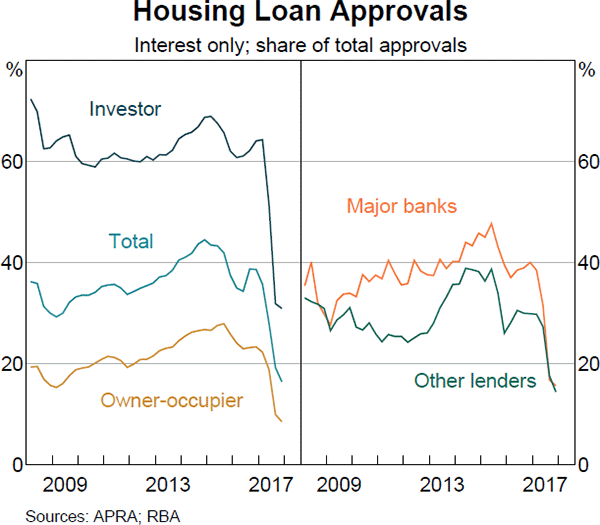
Housing Lending Rates
Standard variable reference (SVR) rates on housing loans have remained stable over recent months. At the same time, data on securitised mortgages reported to the RBA indicate that the average interest rate on outstanding variable rate housing loans has declined slightly (Graph 4.14; Table 4.2).[1] This has mainly been driven by a decline in the average outstanding interest rate for loans requiring principal and interest payments. This decline, in turn, is likely to have reflected a combination of new loans with rates lower than those of outstanding loans and borrowers refinancing their existing loans at lower rates.
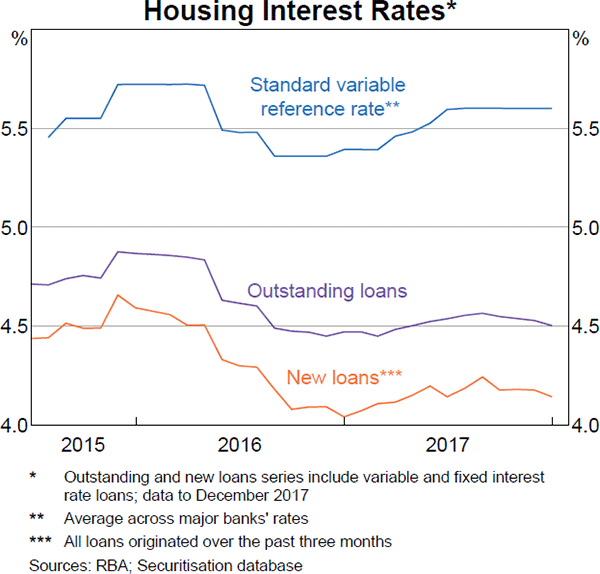
Over the past year, the difference between the variable outstanding housing interest rates offered by authorised deposit-taking institutions (ADIs) and other lenders has declined somewhat (Graph 4.15). Interest rates offered by ADIs increased over the first half of the year, with higher interest rates for investors and interest-only loans. In contrast, the interest rates offered by non-ADIs declined over the year, mainly driven by a decline in the average interest rate charged on principal-and-interest loans for owner-occupiers (Graph 4.16). Although the average rate charged by non-ADIs remains well above the rates charged by ADI lenders, the narrowing of the gap may indicate that non-ADIs are passing through an improvement in funding conditions to their lending rates; RMBS are an important source of funding for non-ADIs and spreads on these securities over benchmark rates have narrowed. It is also possible that as ADI lending growth has slowed, the characteristics of new borrowers serviced by non-ADI lenders could be less risky than their existing borrowers. This has been reflected in a decline in the average rates charged across new and existing borrowers.
| Interest rate Per cent | Change since November 2017 Basis points | Change since November 2016 Basis points | |
|---|---|---|---|
| Housing loans(a) | |||
| – Variable principal-and-interest rate | |||
| – Owner-occupier | 4.29 | −2 | −11 |
| – Investor | 4.74 | −2 | 14 |
| – Variable interest-only rate | |||
| – Owner-occupier | 4.74 | −2 | 42 |
| – Investor | 5.10 | −1 | 61 |
| – Fixed rate | |||
| – Owner-occupier | 4.25 | −2 | −28 |
| – Investor | 4.37 | −1 | −24 |
| – Average outstanding rate | 4.51 | −2 | 6 |
| Personal loans | |||
| – Variable rate(b) | 11.64 | 0 | 14 |
| Small business | |||
| – Term loans variable rate(e) | 6.43 | 0 | 4 |
| – Overdraft variable rate(e) | 7.26 | −5 | −1 |
| – Fixed rate(c)(e) | 5.18 | −6 | −13 |
| – Average outstanding rate(d) | 5.28 | 0 | −8 |
| Large business | |||
| Average outstanding rate(d) | 3.42 | 5 | −7 |
|
(a) Average rates from Securitisation Dataset, updated for end December 2017 Sources: ABS; APRA; Securitisation System; RBA |
|||
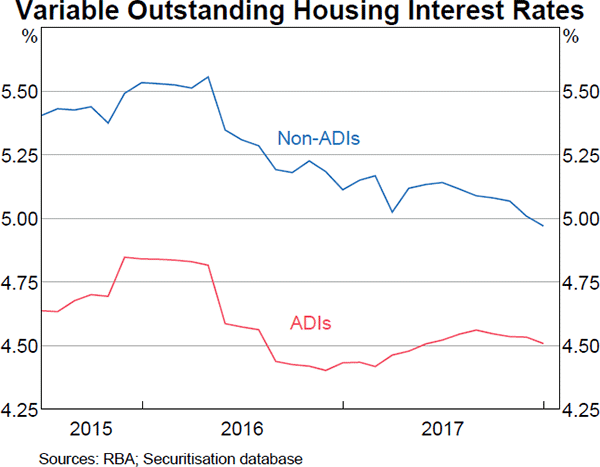
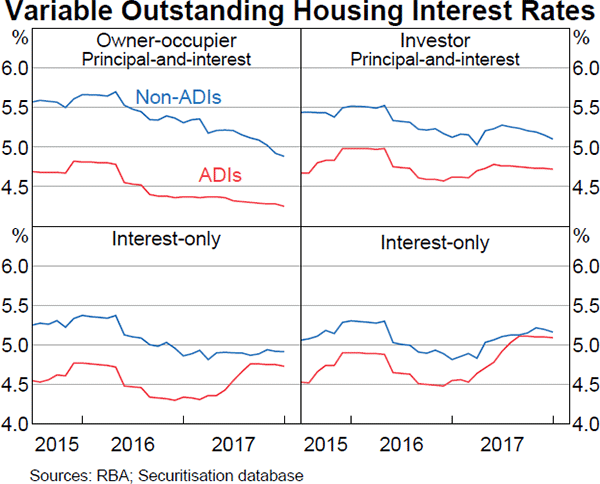
The average interest rate on new fixed-rate housing loans has also declined in recent months, reflecting some rate reductions by the major banks. More recently, one major bank has raised interest rates on fixed-term loans, citing an upwardly revised outlook for interest rates.
Business Financing
Growth in business debt has been moderate in recent years. This is despite interest rates being near historic lows and a pick-up in business investment outside the mining industry (Table 4.1; Graph 4.17). The moderate growth in business debt partly reflects the tendency for businesses to finance investment from internal funding rather than through debt.[2] Growth in debt funding appears to be more linked to mergers and acquisitions activity (M&A), which has been relatively modest over recent years, although some large M&A deals were announced in December.
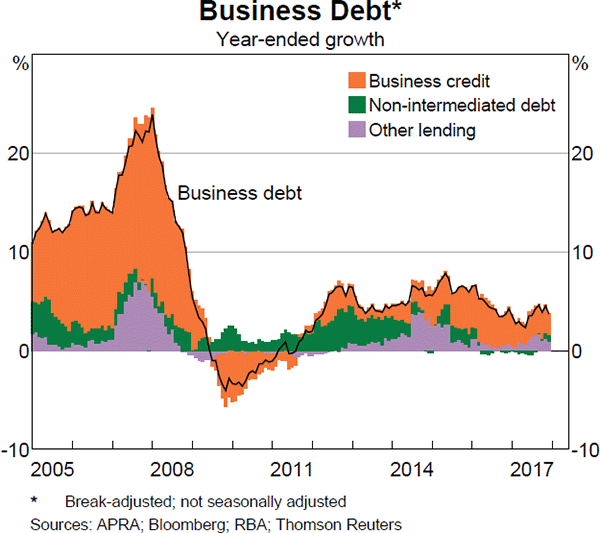
Bond issuance by non-financial corporations in 2017 was around the average of recent years; there was substantial issuance from infrastructure and utilities companies, while issuance by mining companies remained relatively low. This has coincided with strong conditions for issuers; spreads of non-financial corporate bond yields to AGS continued to tighten over 2017 across industries and credit rating bands (Graph 4.18).
Growth in lending to businesses by banks eased slightly in 2017, although lending growth has varied across industries. Lending to the mining sector continued to decline over 2017, consistent with ongoing deleveraging of the sector. While Australian banks still account for around three-quarters of outstanding business credit, the foreign banks' share has increased consistently over the past five years, driven by Chinese and Japanese banks (Graph 4.19).
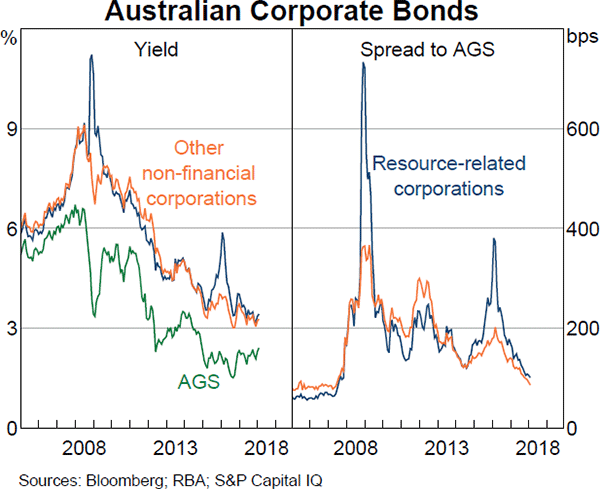
Interest rates on outstanding loans to small and large businesses decreased slightly over 2017 (Graph 4.20).
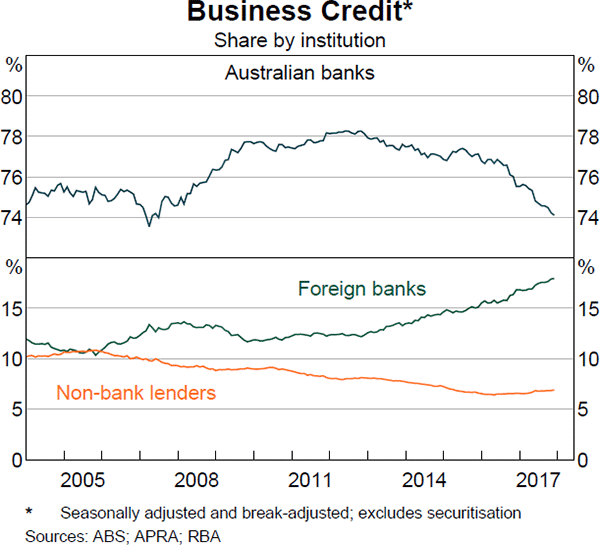
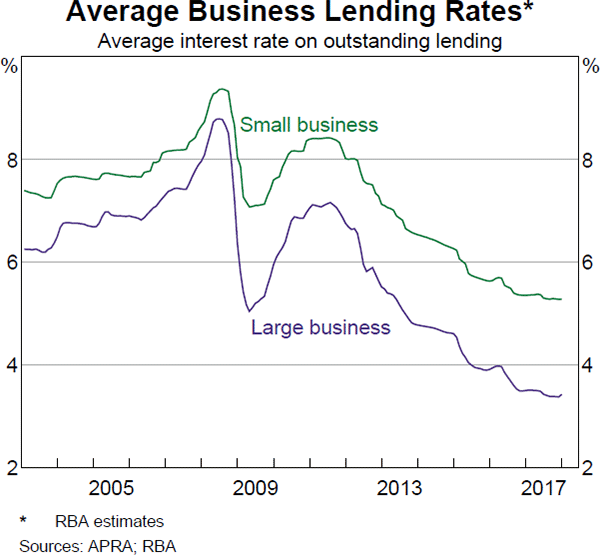
Equity Markets
Volatility in Australian equity markets has picked up recently from historically low levels following global equity markets. Australian equity prices have declined recently but are still above where they were in mid 2017, alongside higher commodity prices and an improving economic outlook. Over the past year, the Australian market has moved broadly in line with global markets outside the United States when performance is compared using accumulation indices, which recognise that Australian companies pay relatively high dividends (Graph 4.21).
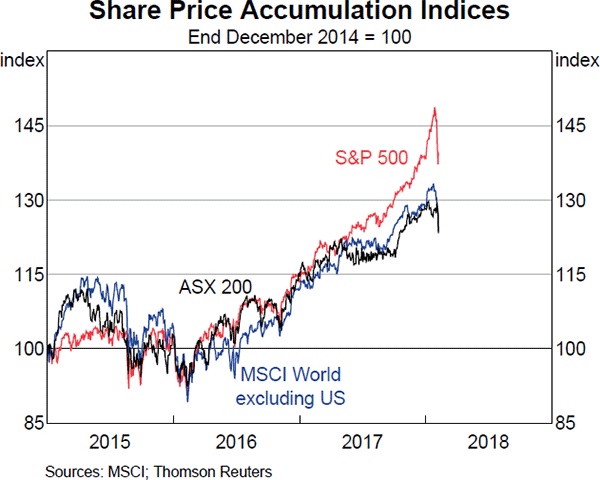
Even after recent market movements, the Australian equity market has underperformed compared with global indices over recent months. This can be partly explained by financial sector share prices. Equity prices of the financial sector were little changed in recent months, in contrast with increases in financial sector equity prices in many other advanced economies. Equity prices for the resources sector have increased significantly, largely in response to higher commodity prices, and have now doubled since their 2016 trough (Graph 4.22). Equity prices for companies outside the financial and resources sectors have also risen over the past year, driven by the healthcare and consumer staples sectors.
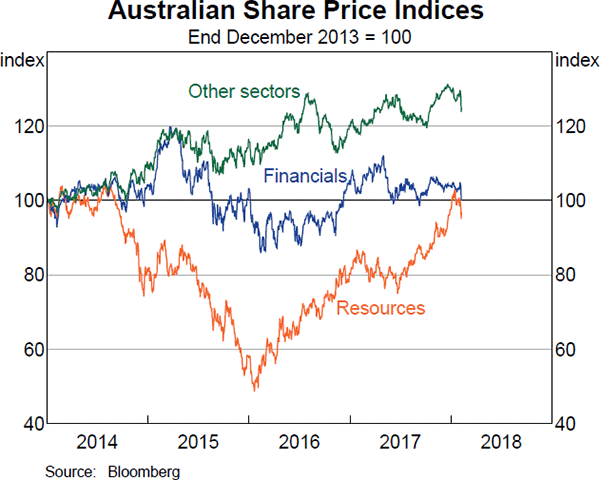
Analysts' expectations for listed company earnings have been little changed in recent months. Share price valuations – as measured by price-to-earnings ratios – remain slightly above recent averages for most sectors (Graph 4.23).
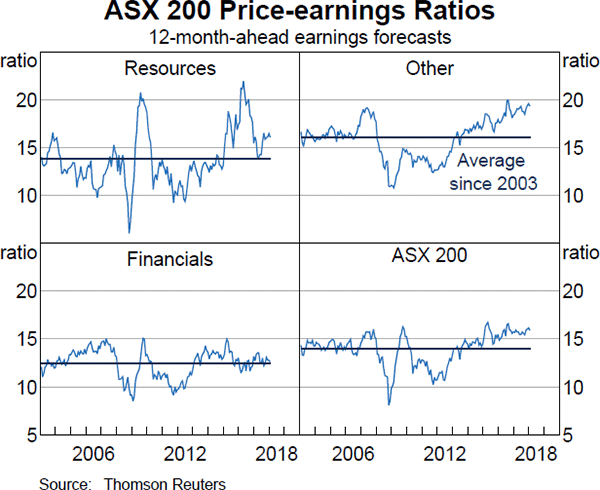
Footnotes
The Securitisation Dataset covers a significant share of the market for housing loans and provides useful indicators of developments in home lending, although loans in the dataset may have different characteristics from those not covered by the dataset. See Kent C (2017), ‘Some Innovative Mortgage Data’, Speech at Moody's Analytics Australia Conference 2017, Sydney, 14 August. See also Kohler M (2017), ‘Mortgage Insights From Securitisation Data’, Speech at Australian Securitisation Forum, Sydney, 20 November. [1]
See Kent C (2017), ‘The Availability of Business Finance’, Speech at 30th Australasian Finance and Banking Conference, Sydney, 13 December. [2]